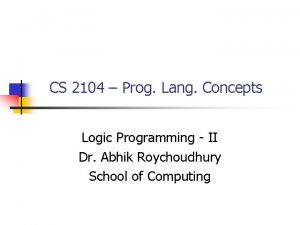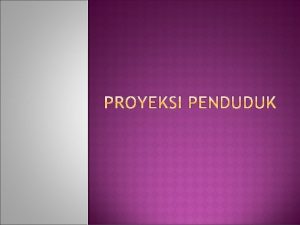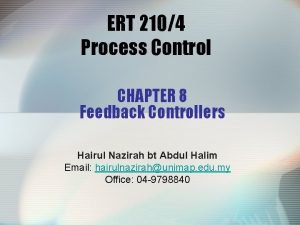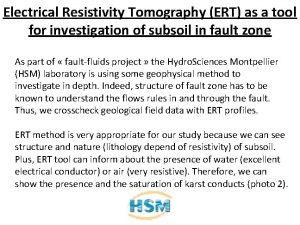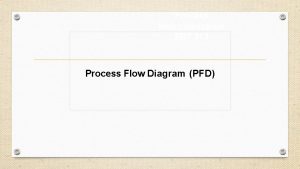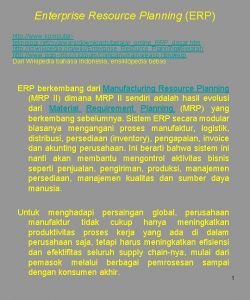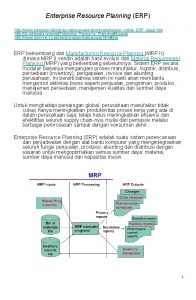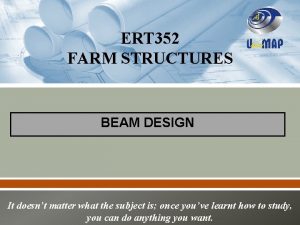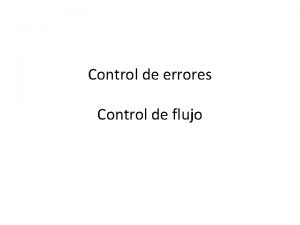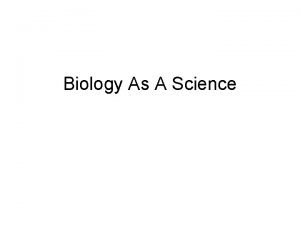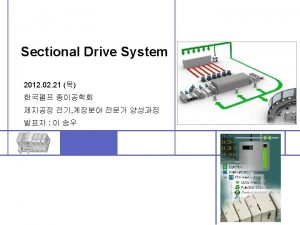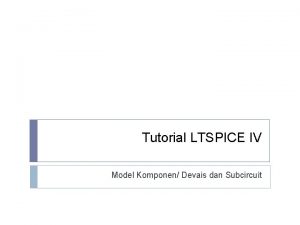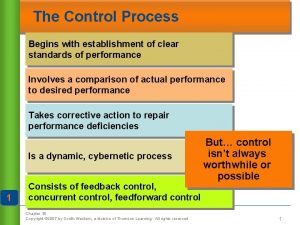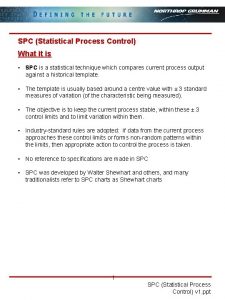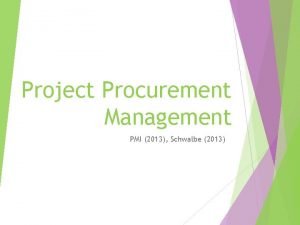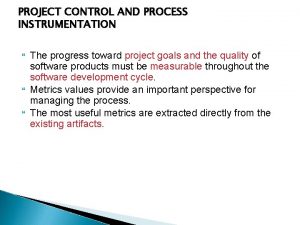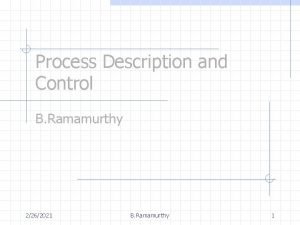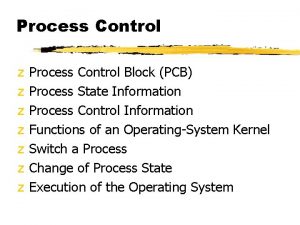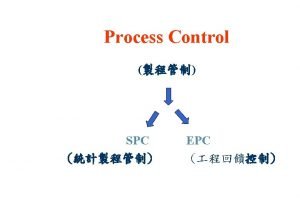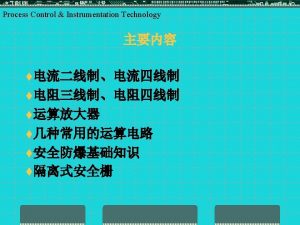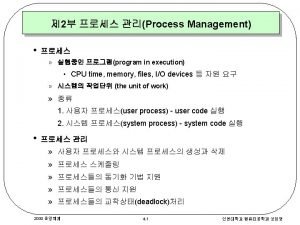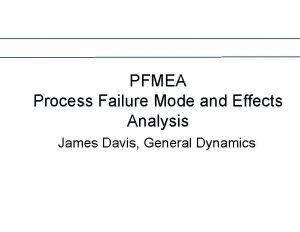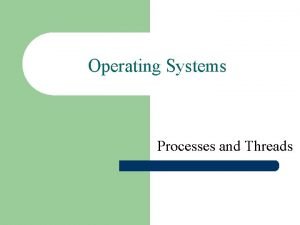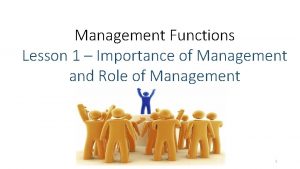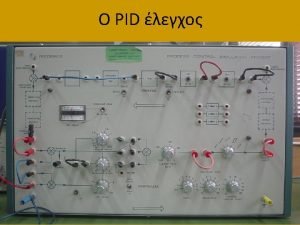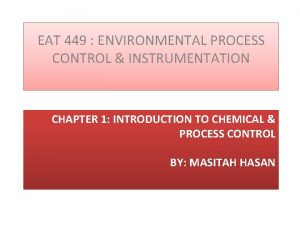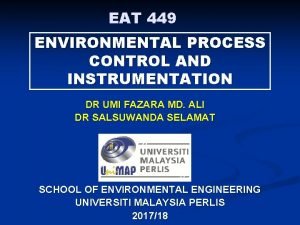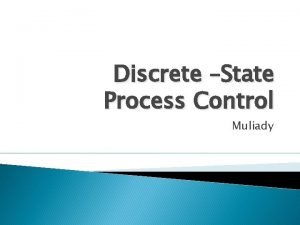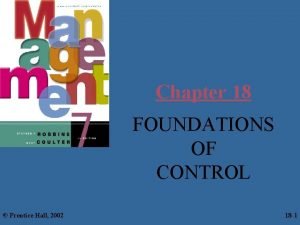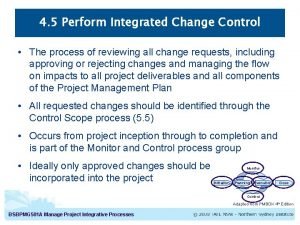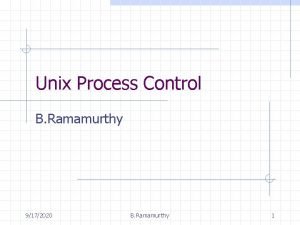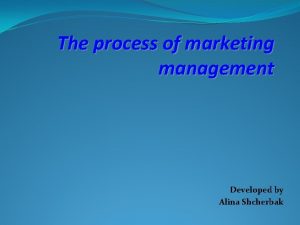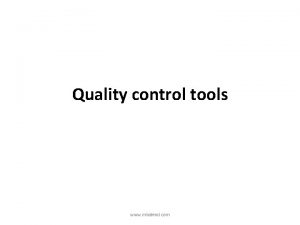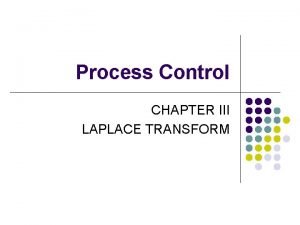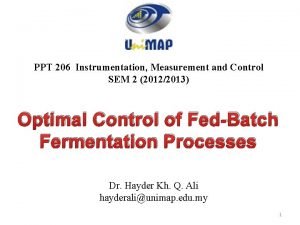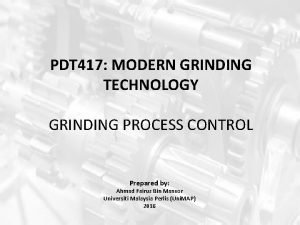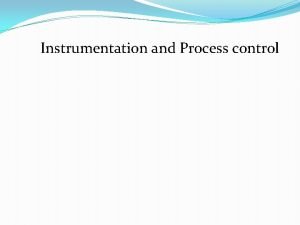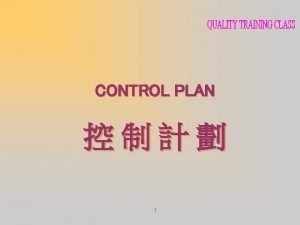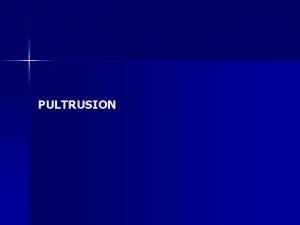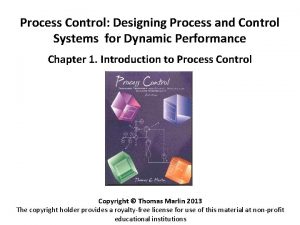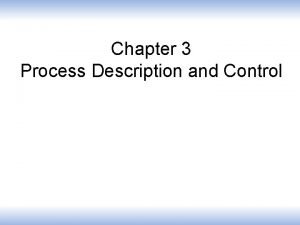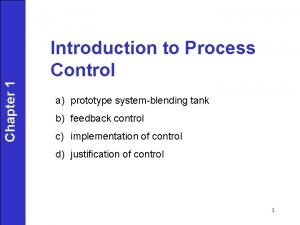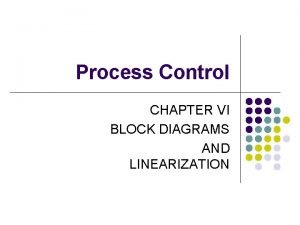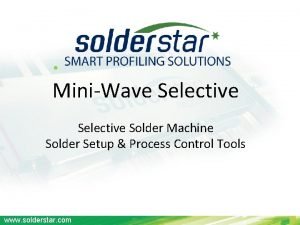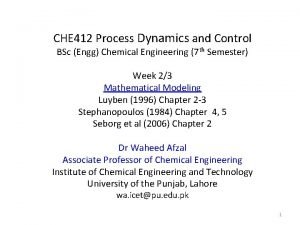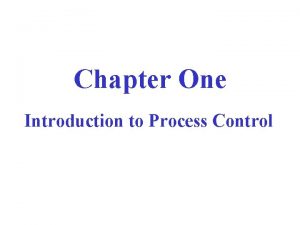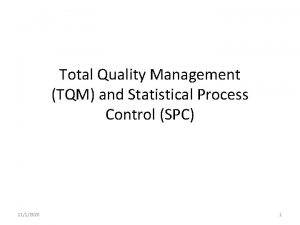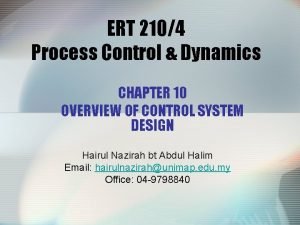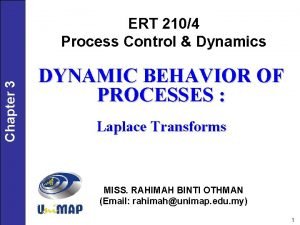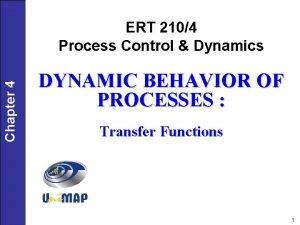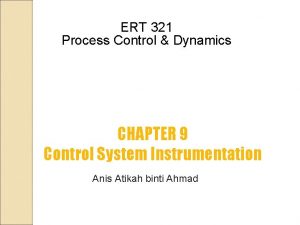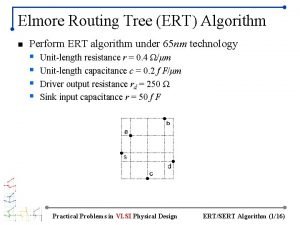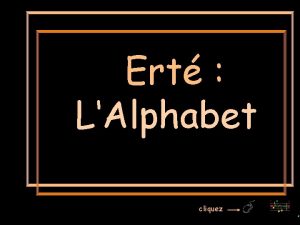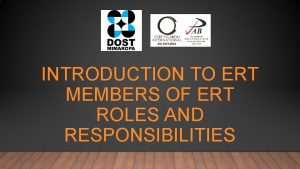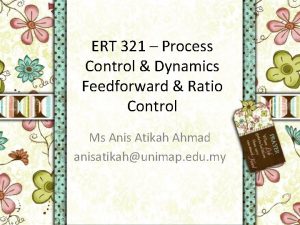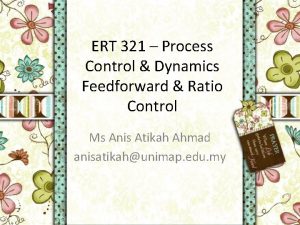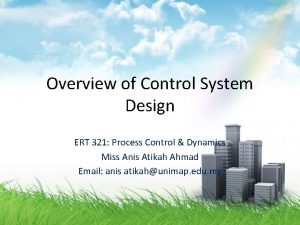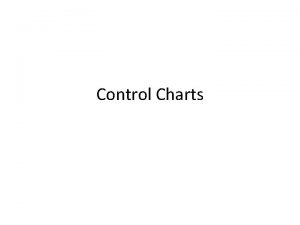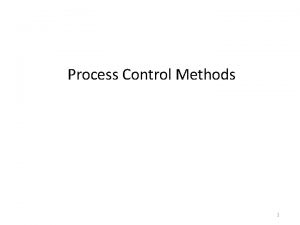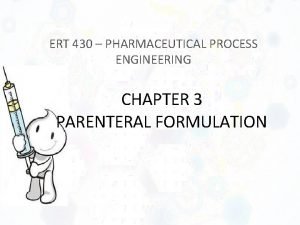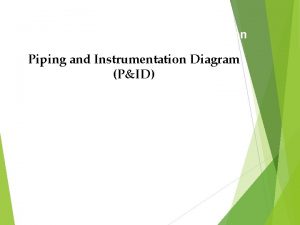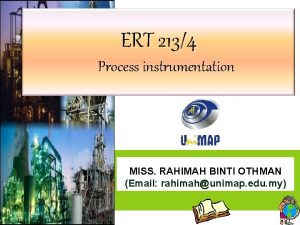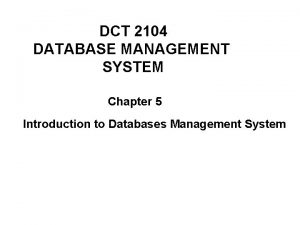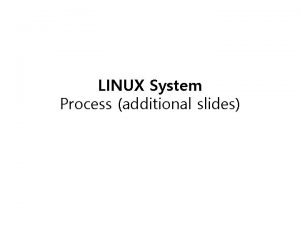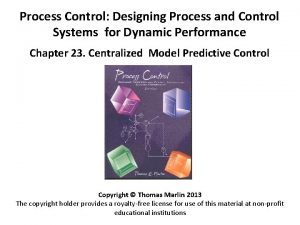Chapter 11 ERT 2104 Process Control CHAPTER 11




























































- Slides: 60

Chapter 11 ERT 210/4 Process Control CHAPTER 11 DYNAMIC BEHAVIOR AND STABILITY OF CLOSED-LOOP CONTROL SYSTEMS 1

Course Outcome CH 11 & 12 Chapter 11 CO 3: Ability to calculate and analyze the dynamic behavior of closed-loop control system (CH 11), PID controller design and troubleshooting (CH 12). 2

Chapter 11 Topic Outline 1. • • • Block Diagram Representation Process Sensor – Transmitter Controller Current-to-Pressure (I/P) Transducer Control valve 3

Chapter 11 Con’t 2. Closed-Loop Transfer Function - Block Diagram Reduction - Set Point Changes - Disturbance Changes 4

Chapter 11 Dynamic Behavior of Closed-Loop Control Systems • Dynamic behavior of processes that are operated using feedback control. • Feedback control loop or a closed-loop system – combination of: Feedback Controller + Instrumentation 5

Chapter 11 Block Diagram Representation Figure 11. 1 Composition control system for a stirred-tank blending process. 6

Chapter 11 Figure 11. 7 Block diagram for the entire blending process composition control system. 7

Process Chapter 11 In section 4. 3 the approximate dynamic model of a stirred-tank blending system was developed: where 8

Chapter 11 Figure 11. 2 Block diagram of the process. 9

Composition Sensor-Transmitter (Analyzer) Chapter 11 Assume that the dynamic behavior: first-order transfer function: Negligible dynamics; τm = 0, so: 10

Chapter 11 Figure 11. 3 Block diagram for the composition sensor-transmitter (analyzer). 11

Controller Chapter 11 Suppose that an electronic PI controller is used. From Chapter 8, the controller transfer function is 12

Chapter 11 The error signal is expressed as: or after taking Laplace transforms, 13

= internal set-point composition Chapter 11 = actual set point composition Thus 14

Chapter 11 Current-to-Pressure (I/P) Transducer Because transducers are usually designed to have linear characteristics and negligible dynamics (fast), we assume that the transducer transfer function merely consists of a steady-state gain KIP: 15

Chapter 11 Figure 11. 5 Block diagram for the I/P transducer. 16

Chapter 11 Control Valve Control valves are usually designed so that the flow rate through the valve is a nearly linear function of the signal to the valve actuator. first-order transfer function usually provides an adequate model for operation: 17

Chapter 11 Figure 11. 6 Block diagram for the control valve. 18

Chapter 11 Figure 11. 7 Block diagram for the entire blending process composition control system. 19

Chapter 11 Closed-Loop Transfer Functions The general block diagram in Fig. 11. 8 contains the standard notation: Y = controlled variable U = manipulated variable D = disturbance variable (also referred to as load variable) P = controller output E = error signal Ym = measured value of Y Ysp = set point internal set point (used by the controller) 20

Chapter 11 Yu = Yd = Gc = Gv = Gp = Gd = Gm = Km = change in Y due to U change in Y due to D controller transfer function for final control element (including KIP, if required) process transfer function disturbance transfer function for measuring element and transmitter steady-state gain for Gm 21

Chapter 11 Figure 11. 8 Standard block diagram of a feedback control system. 22

Block Diagram Reduction Chapter 11 In deriving closed-loop transfer functions, it is often convenient to combine several blocks into a single block. Figure 11. 10 Figure 11. 11 Three blocks in series. Equivalent block diagram. 23

Block Diagram Reduction Chapter 11 The block diagram indicates the following relations: 24

Chapter 11 By successive substitution, or Where: = 25

Closed-loop transfer function for Set-Point Changes Chapter 11 Known as the servomechanism (servo) problem. Assume no disturbance change. Combining gives: 26

Chapter 11 Figure 11. 8 also indicates the following input/output relations for the individual blocks: 27

Chapter 11 Combining the above equations gives: 28

Chapter 11 Rearranging gives the desired closed-loop transfer function, 29

Chapter 11 Closed-loop transfer function for Disturbance Changes Known as the regulator problem since the process is to be regulated at a constant set point. From Fig. 11. 8, Substituting (11 -18) through (11 -22) gives 30

Chapter 11 Because Ysp = 0 we can arrange (11 -28) to give the closed-loop transfer function for disturbance changes: • A comparison of Eqs. 11 -26 and 11 -29: both closed-loop transfer functions have the same denominator, 1 + Gc. Gv. Gp. Gm. • The denominator is often written as 1 + GOL where GOL is the open-loop transfer function, 31

Chapter 11 = At different points in the above derivations, we assumed that D = 0 or Ysp = 0, that is, that one of the two inputs was constant. But suppose that D ≠ 0 and Ysp ≠ 0, as would be the case if a disturbance occurs during a set-point change. 32

Chapter 11 To analyze this situation, we rearrange Eq. 11 -28 and substitute the definition of GOL to obtain Thus, the response to simultaneous disturbance variable and set-point changes is merely the sum of the individual responses. 33

Chapter 11 Closed-Loop Responses of Simple Control Systems In this section we consider the dynamic behavior of: a) Proportional Control and Set-point Changes b) Proportional Control and Disturbance Changes c) PI Control and Disturbance Changes d) PI Control of an Integrating Process 34

Chapter 11 Figure 11. 15 Liquid-level control system. 35

Chapter 11 • The transient responses can be determined in a straightforward manner if the closed-loop transfer functions are available. • Consider the liquid-level control system shown in Fig. 11. 15. • The liquid level is measured and the level transmitter (LT) output is sent to a feedback controller (LC) that controls liquid level by adjusting volumetric flow rate q 2. • A second inlet flow rate q 1 is the disturbance variable. 36

Chapter 11 Assume: 1. The liquid density ρ and the cross-sectional area of the tank A are constant. 2. The flow-head relation is linear, q 3 = h/R. 3. The level transmitter, I/P transducer, and control valve have negligible dynamics. 4. An electronic controller with input and output in % is used (full scale = 100%). 37

Derivation of the process and disturbance transfer functions directly follows Example 4. 4. Chapter 11 Consider the unsteady-state mass balance for the tank contents: Substituting the flow-head relation, q 3 = h/R, and introducing deviation variables gives 38

Chapter 11 Thus, we obtain the transfer functions; where Kp = R and = RA. Note that Gp(s) and Gd(s) are identical because q 1 and q 2 are both inlet flow rates and thus have the same effect on h. 39

Chapter 11 Figure 11. 16 Block diagram for level control system. 40

Proportional Control and Set-Point Changes Chapter 11 If a proportional controller is used, then Gc(s) = Kc. From Fig. 11. 16 and the material in the previous section, the closed-loop transfer function for setpoint changes is given by 41

Chapter 11 This relation can be rearranged in the standard form for a first-order transfer function, where: 42

Chapter 11 The closed-loop response to a unit step change of magnitude M in set point is given by: Offset: = 43

Chapter 11 Figure 11. 17 Step response for proportional control (set-point change). 44

Proportional Control and Disturbance Changes Chapter 11 From Fig. 11. 16 and Eq. 11 -29 the closed-loop transfer function for disturbance changes with proportional control is rearranged in the standard form for a first-order transfer function 45

Chapter 11 Where: 46

Chapter 11 • The closed-loop response to a step change in disturbance of magnitude M is given by Offset: 47

Chapter 11 Figure 11. 19 Disturbance responses for Example 11. 3. 48

PI Control and Disturbance Changes Chapter 11 For PI control, . The closed-loop transfer function for disturbance changes can then be derived from Fig. 11. 16: Clearing terms in the denominator gives (11 -59) 49

Chapter 11 Further rearrangement allows the denominator to be placed in the standard form for a second-order transfer function: Where: 50

Chapter 11 For a unit step change in disturbance, , and (11 -59) becomes For , the response is a damped oscillation that can be described by 51

Chapter 11 • Refer to Figure 11. 21 (text book) • Increasing Kc or decreasing τI tends to speed up the response • Response more oscillatory as either Kc or τI decreases. 52

PI Control of an Integrating Process Chapter 11 • Consider the liquid-level control system shown in Fig. 11. 22. • This system differs from the previous example in two ways: 1. the exit line contains a pump and 2. the manipulated variable is the exit flow rate rather than an inlet flow rate. 53

Chapter 11 Figure 11. 22 Liquid-level control system with pump in exit line. 54

Chapter 11 In Section 5. 3 we saw that a tank with a pump in the exit stream can act as an integrator with respect to flow rate changes because 55

If the level transmitter and control valve in Eq. 11. 22 have negligible dynamics, Chapter 11 Gm(s) = Km and Gv(s) = Kv. For PI control, . Substituting these expressions into the closed-loop transfer function for disturbance changes 56

Chapter 11 and rearranging gives where And KOL = Kc. Kv. Kp. Km with Kp = - 1/A. 57

Chapter 11 • Degree of oscillation can be reduced by increasing either Kc or τI. • If τI is constant, the effect of Kc: Value of Kc Small Moderate or large Closed-loop response Oscillatory Overdamped (nonoscillatory) Very large Oscillatory or unstable 58

Chapter 11 Stability of Closed-Loop Control Systems • If the oscillatory has a small amplitude and damps out quickly---considered to be satisfactory • If the oscillations undamped or the amplitude increases with time until physical limit reached---unstable. 59

Chapter 11 Figure 11. 23. Effect of controller gains on closed-loop response to a unit step change in set point (example 11. 1). 60
 Cs2104
Cs2104 Pt = p.ert merupakan rumus dari pertumbuhan penduduk
Pt = p.ert merupakan rumus dari pertumbuhan penduduk Transfer function of pid controller is
Transfer function of pid controller is Ert tool
Ert tool Ert diagram
Ert diagram Ert erp definition
Ert erp definition Ert erp definition
Ert erp definition Ert 1 programa
Ert 1 programa Ert malaysia
Ert malaysia Two way slab load distribution
Two way slab load distribution Process control and product control
Process control and product control Primary control vs secondary control
Primary control vs secondary control Fluids mechanics
Fluids mechanics Stock control e flow control
Stock control e flow control Control volume vs control surface
Control volume vs control surface Difference between positive and negative control
Difference between positive and negative control Negative control
Negative control Jelaskan tentang error control pada data link control?
Jelaskan tentang error control pada data link control? Control de errores
Control de errores Negative control vs positive control examples
Negative control vs positive control examples Flow control and error control
Flow control and error control Sectional drive
Sectional drive Komponen pada ltspice
Komponen pada ltspice Balanced scorecard for airlines
Balanced scorecard for airlines Statistical process control ppt
Statistical process control ppt Process control systems
Process control systems Procurement negotiations pmp
Procurement negotiations pmp Project control and process instrumentation in spm
Project control and process instrumentation in spm Explain the process control block
Explain the process control block Unix process state transition diagram
Unix process state transition diagram Spc techniques
Spc techniques Process control instrumentation technology
Process control instrumentation technology Split range
Split range Process control block pcb
Process control block pcb Aiag pfmea
Aiag pfmea Slidetodoc.com
Slidetodoc.com Example of middle level management
Example of middle level management Distance velocity lag
Distance velocity lag Environmental process control
Environmental process control Environmental process control
Environmental process control Discrete process control
Discrete process control The control process assumes that
The control process assumes that Perform integrated change control process
Perform integrated change control process Process control in unix
Process control in unix Marketing control process
Marketing control process Quality control process flow chart
Quality control process flow chart Table of inverse laplace transform
Table of inverse laplace transform Computer control of fermentation process ppt
Computer control of fermentation process ppt Grinding tools
Grinding tools Measuring element in process control
Measuring element in process control Process control plan
Process control plan Plc mixer process control problem
Plc mixer process control problem Advantages of pultrusion process
Advantages of pultrusion process Process control design
Process control design Process description and control in operating system
Process description and control in operating system Blending tank process control
Blending tank process control Process control block diagram
Process control block diagram Mini selective wave soldering machine
Mini selective wave soldering machine Degree of freedom analysis in process control
Degree of freedom analysis in process control Introduction to process control
Introduction to process control Grandfather of tqm
Grandfather of tqm
